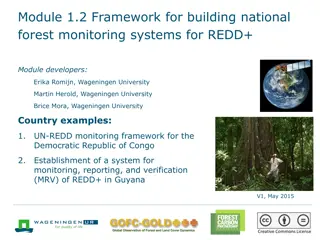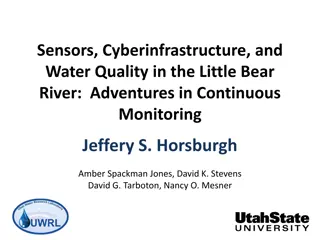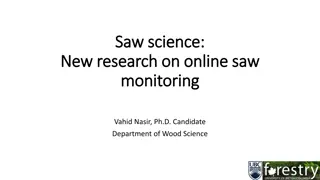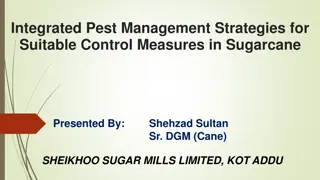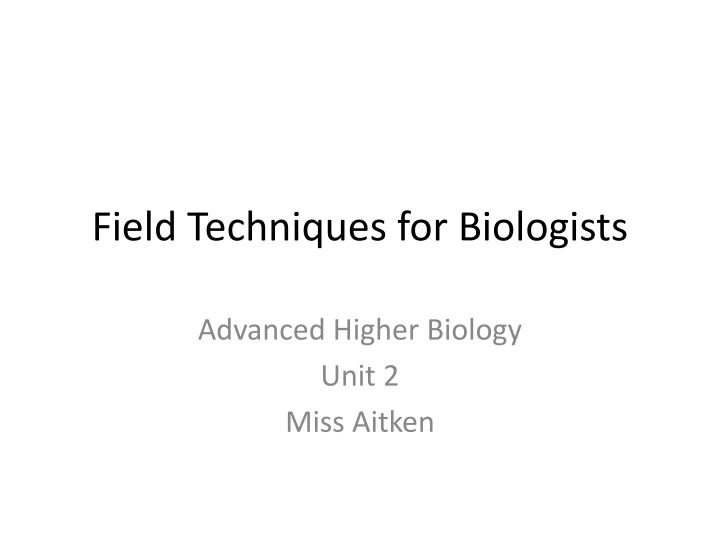
Advanced Field Techniques for Biologists in Biology Unit 2
Explore the essential field techniques for biologists in Advanced Higher Biology Unit 2. Learn about health and safety risks in fieldwork, risk assessments, sampling wild organisms, and various sampling techniques like point count, transect, remote detection, and quadrats. Understand the importance of minimizing impact on nature and protecting rare species. Stay informed and prepared for conducting fieldwork safely and effectively.
Download Presentation

Please find below an Image/Link to download the presentation.
The content on the website is provided AS IS for your information and personal use only. It may not be sold, licensed, or shared on other websites without obtaining consent from the author. If you encounter any issues during the download, it is possible that the publisher has removed the file from their server.
You are allowed to download the files provided on this website for personal or commercial use, subject to the condition that they are used lawfully. All files are the property of their respective owners.
The content on the website is provided AS IS for your information and personal use only. It may not be sold, licensed, or shared on other websites without obtaining consent from the author.
E N D
Presentation Transcript
Field Techniques for Biologists Advanced Higher Biology Unit 2 Miss Aitken
Health and Safety Risks in Fieldwork Wider range of hazards than being in a lab Terrain (ground) hazards associated with uneven ground must be considered Weather conditions even a relatively safe area can become hazardous in bad weather Isolation people can become isolated and injured, separated from others etc.
Health and Safety Risk Assessments Risk assessments required when outside Identify foreseeable hazards How likely is there to be an event? How harmful could an event be? How can the risk be lowered? How will this be recorded?
Sampling Wild Organisms Minimise impact on animals and plants Leave places as you find them Rare species and vulnerable habitats must be protected and are covered by legislation (Wildlife and Countryside Act 1981) It may be illegal to sample in some areas where animals and plants are protected by law.
Sampling Techniques Point Count: A point count is carried out from a stationary location. Gather observational data - Often used in sampling bird numbers in a population.
Sampling Techniques Transect: Used for determining changes in community across an environmental gradient. Either a line transect or a band transect For example, extending a line down a hill and measuring the moisture or pH level every meter, and recording changes.
Sampling Techniques Remote Detection: Carried out using satellite Mostly used in plant sampling Counts and measurements done from the air (sometimes from space)
Sampling Techniques Quadrats: Useful for monitoring plant population Also useful for sessile organisms like barnacles
Sampling Techniques Mobile species Sampling a moving species is more difficult Traps required Nets may also be used Animals must be released unharmed
Sampling Techniques Elusive species Some animals are very difficult to sample through normal observations Camera traps Scat (droppings/faeces) sampling This provides indirect evidence
Life on Earth 1.5 million species have been named and described 10 million species may be living on Earth that have not yet been named Another 1 billion species of unnamed species are extinct
Life on Earth All life on Earth is related and our last common ancestor existed around 3.5 million years ago. Scientists try to prove relations between animals by studying their DNA and comparing it.
Life on Earth Identification: The ability to put a species name to a sample. Can be done using: classification guides, biological keys, by analysis of DNA or by analysis of proteins made.
Life on Earth Classification guides: focus on one class of organisms from one part of the world e.g. Types of cichlid Africa. Tend to native to
Life on Earth Biological Key: A series of questions posed, usually in the form of paired statements, which focus only on the features by which the organisms can be separated.
Life on Earth DNA Analysis: This is a powerful technique for separating organisms that only have subtle differences. In addition, it allows identification of organisms where only some example, in fossils. evidence remains, for
Taxonomy Taxonomy is the organisation of life into a hierarchy of groups of increasingly related species. These groups are known as domains, kingdoms, phyla, classes, orders, families, genera and species. If the taxonomic groupings are known for a particular animal, scientists can make assumptions about an organism based on its relations.
Taxonomy Example: Cheetah Multicellular, motile Possesses a spinal cord Opening in the skull behind eye Mammary glands, 3 ear bones Meat-eating organism Protracted claws and other characteristics which separate the family from other carnivores. Sub-family of cats that purr Species name
Taxonomy Example: Spiny Seahorse Multicellular, motile Possesses a spinal cord Ray-finned Narrow body, tubular mouth Fused jaws Upright posture, prehensile tail Covered in thorns
Model Organisms Organisms which have their entire genomes sequenced, and so can be studied in different ways: Escherichia coli Arabidopsis thaliana Caenorhabditis elegans Drosophilia melanogaster
Patterns of Evolution Thousands of genetic studies have been carried out to give a more definitive picture of the tree of life . The comparison of DNA sequences reveals that life has diverged into three domains: Archaea Bacteria Eukaryota
Patterns of Evolution Thousands of genetic studies have been carried out to give a more definitive picture of the tree of life . The comparison of DNA sequences reveals that life has diverged into three domains: Archaea Bacteria Eukaryota
Types of Evolution Evolution can produce closely related species which look very different to one another, and distantly related species which look very similar. Write a note on Divergent Evolution and Convergent Evolution from page 54 and 55 of the textbook.
Family Trees There is overwhelming evidence to support the theory that all life is related and has evolved into the diversity we see today. Write a note on each of the three domains from page 55 of the textbook: Bacteria Eukaryota Archaea
The Kingdom of Eukaryota This is the most well-known kingdom. It can be split into 3: Plants Animals Fungi
Divisions of Plants The kingdom of plants can be split further into 5 main divisions. They are called: Moss Liverworts Ferns Conifers Flowering plants That s all you need to know about that.
Divisions of Animals The kingdom of animals can be split further into 5 main divisions called phyla. They are called: Chordata animals with a spinal cord Arthropoda animals with leg joints and segmented bodies mostly insects and crabs Nematoda Round worms, mostly parasites Platyhelminthes Flat worms, mostly parasites Mollusa animals with shells
Indicator Species A species which tells us about the environmental conditions in an area by it s presence or absence, or in some cases, it s abundance. E.g. mayfly nymphs are only found in clean water with low pollution. Their abundance is important if there are MANY of the insects, the water is extremely clean.
Methods of Marking When monitoring populations it is helpful to identify individual organisms. Banding - birds Tagging cows/whales Surgical implant - dogs Painting - sheep Hair clipping small mammals
Mark and Recapture A method for estimating population size (N). A sample of the population are captured and marked (M) and then released. After an interval of time, a second sample is captured (C). Some of the animals are captured twice/recaptured (R) N = (MC)/R Assuming all individuals have an equal chance of capture, and that no immigration or emigration has occurred.
Measuring and Recording Animal Behaviour Behaviour is complex and scientists studying behaviour have to be aware of this. Most scientific studies use a reductionist approach, and break behaviour down into categories e.g. Latency the time between a stimulus and a response Frequency how often a behaviour occurs Duration the length of time behaviour occurs
Anthropomorphism Anthropomorphism is the attribution of human motivation, characteristics or behaviour to non-human animals. For example, saying that a fish carrying out a zig-zag dance is confused or excited .
Ethograms An ethogram describes all the behaviours shown by a species in a wild context, allowing observation and recording of time spent carrying out each type of behaviour. Behaviour Description Foraging Searching for food Feeding Grabbing food Cannabalism Feeding on eggs Escaping Rapid swimming ahead of other fish Courtship Swimming slowly close to female, holding body at angle, entering nest etc Reproduction Laying eggs, fertilising eggs etc Parental Care Fanning nest with fins









